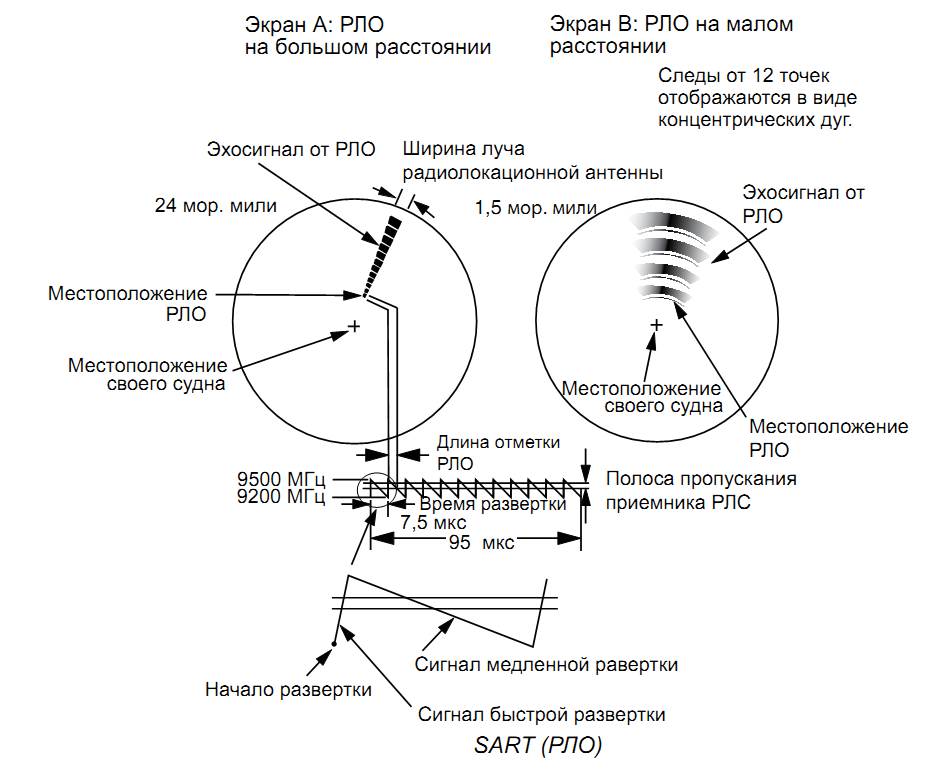SART
24.12.2013
When the distance from the radar to the SART is reduced to about 1 nm on radar display can also see the 12 responses received during the 'fast' scans. These additional dot responses which evenly spaced apart by 0.64 nm are 'woven' in the original series of 12 points.Thus they will be weaker and less amount than the initial point.
 It is generally aligned with the radar pulse length and usually varies with the distance range and the corresponding pulse width. Narrow bandwidth (5.3 MHz) are used with long pulses on a large scale ranges and broad band transmission (10-25 MHz) - with short pulses on short ranges.
It is generally aligned with the radar pulse length and usually varies with the distance range and the corresponding pulse width. Narrow bandwidth (5.3 MHz) are used with long pulses on a large scale ranges and broad band transmission (10-25 MHz) - with short pulses on short ranges.
Radar bandwidth of less than 5 MHz will slightly weaken the SART signal, so it is preferable to use the middle lane bandwidth to ensure optimum detection of the SART.
Иностранный язык: en
SART
Radar transponder (SART) may be activated by a signal from any radar 3-cm band (X-band) in the range of range of about 8 nautical miles. Each time the decision signal from the radar emits a series of respondent reply pulse frequency which varies periodically throughout the frequency range radar.When activated, the SART first rapidly (within 0.4 ms) range runs, after which it starts relatively slow (in 7.5 ms) transition back to the initial frequency.This process was repeated 12 times. At some point in each cycle SART frequency will match exactly with the frequency of the radar trigger the SART, and thus within the bandwidth radar receiver. If RLS is within the range of the radar to match the frequency for each of a series of slow cycles 12 generates a response signal on the radar screen. Thus, the screen will display a line of 12 points, spaced at a distance of approximately 0.64 nautical miles.When the distance from the radar to the SART is reduced to about 1 nm on radar display can also see the 12 responses received during the 'fast' scans. These additional dot responses which evenly spaced apart by 0.64 nm are 'woven' in the original series of 12 points.Thus they will be weaker and less amount than the initial point.

General remarks on receiving SART signals
Errors in range SART If you see only the response signals from the 12 low-frequency sweeps (SART deleted when more than 1 nm), a position in which there is a first point can be significantly (up to 0.64 mor. miles) on the true position of the SART . As we approach the RLS when they become visible and also the response signals from the fast sweeps, the first of these signals will defend away from the true position of not more than 150 mBandwidth Radar
Radar bandwidth of less than 5 MHz will slightly weaken the SART signal, so it is preferable to use the middle lane bandwidth to ensure optimum detection of the SART.
Radar sidelobes
As we approach the SART, radar antenna side lobes may show the SART response parcels as a series of concentric arcs or circles. This can eliminate the interference cancellation controller from the sea, although this phenomenon can be useful, because the signals of the side lobes may be more effective in detecting conditions of rain and, in addition, is confirmed by the proximity of the vessel RLS.
Note: This information is taken from the SART IMO SN / Circ 197 OPERATION OF MARINE RADAR FOR DETECTION SART (SHIP WORK radar to detect radar transponder).
Иностранный язык: en
 +7 (812) 4-673-673
+7 (812) 4-673-673
